Managing Tourism Activity | Climate Change
VerifiedAdded on 2022/08/30
|12
|3640
|15
AI Summary
Contribute Materials
Your contribution can guide someone’s learning journey. Share your
documents today.
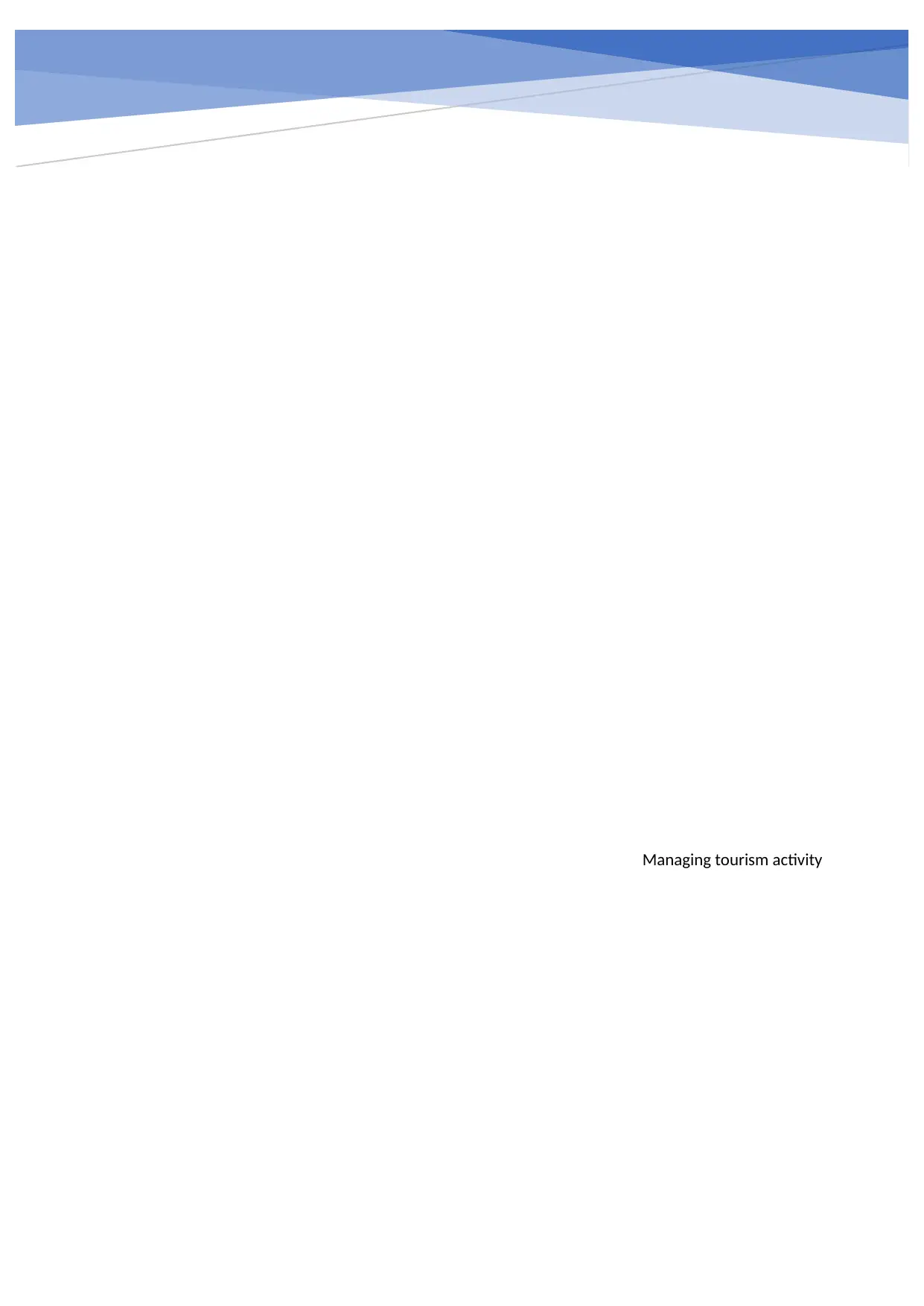
Managing tourism activity
Secure Best Marks with AI Grader
Need help grading? Try our AI Grader for instant feedback on your assignments.
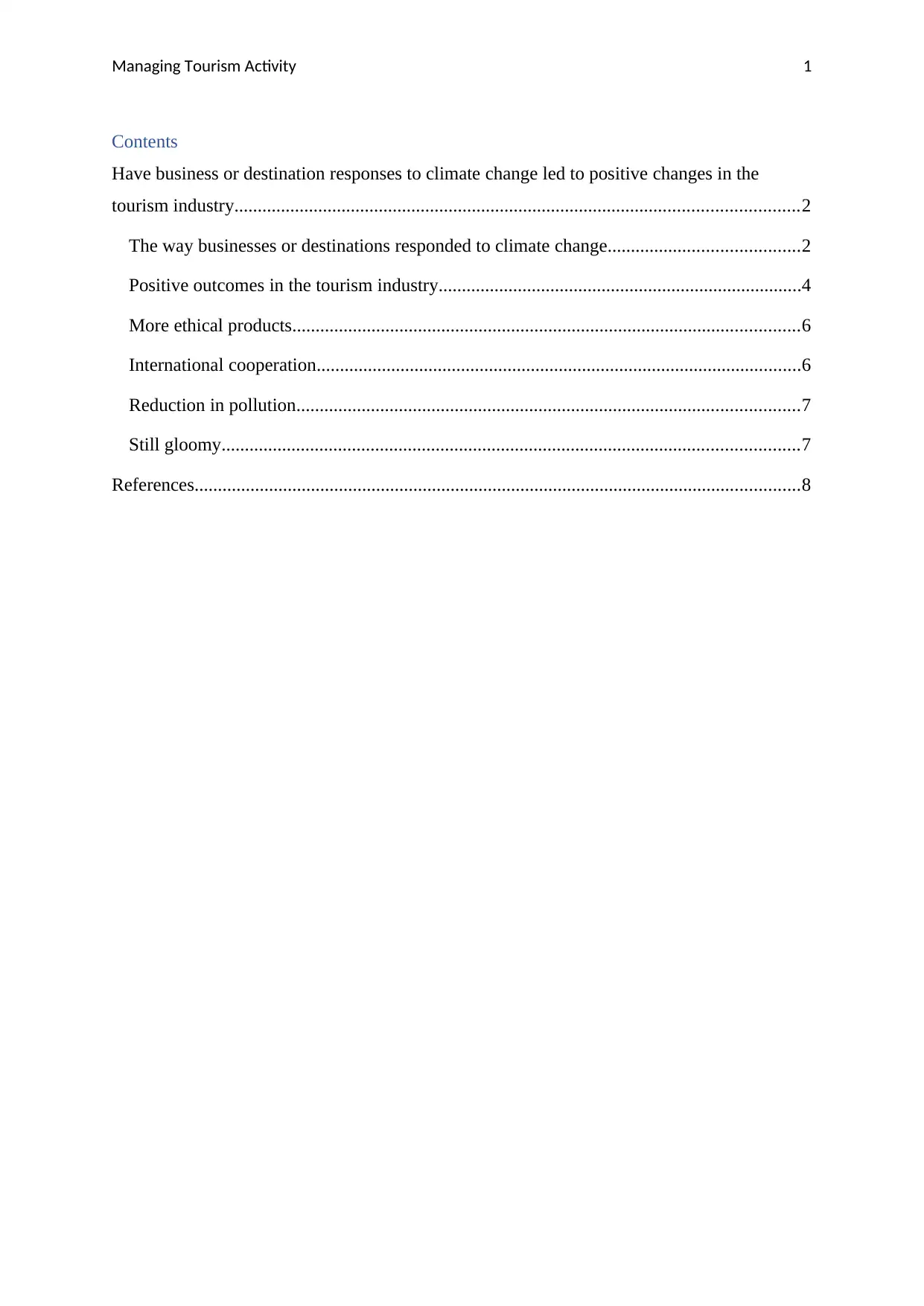
Managing Tourism Activity 1
Contents
Have business or destination responses to climate change led to positive changes in the
tourism industry.........................................................................................................................2
The way businesses or destinations responded to climate change.........................................2
Positive outcomes in the tourism industry..............................................................................4
More ethical products.............................................................................................................6
International cooperation........................................................................................................6
Reduction in pollution............................................................................................................7
Still gloomy............................................................................................................................7
References..................................................................................................................................8
Contents
Have business or destination responses to climate change led to positive changes in the
tourism industry.........................................................................................................................2
The way businesses or destinations responded to climate change.........................................2
Positive outcomes in the tourism industry..............................................................................4
More ethical products.............................................................................................................6
International cooperation........................................................................................................6
Reduction in pollution............................................................................................................7
Still gloomy............................................................................................................................7
References..................................................................................................................................8
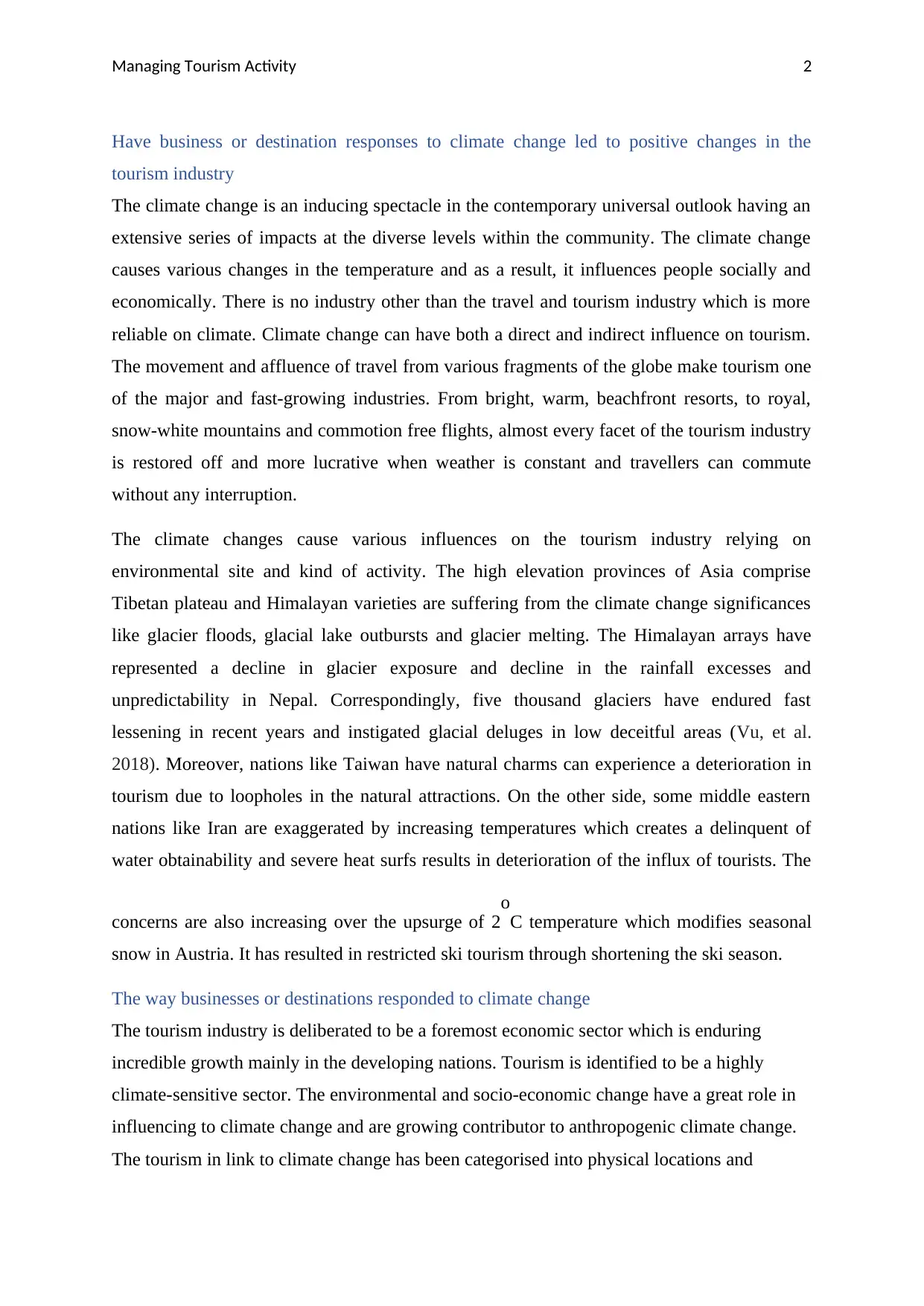
Managing Tourism Activity 2
Have business or destination responses to climate change led to positive changes in the
tourism industry
The climate change is an inducing spectacle in the contemporary universal outlook having an
extensive series of impacts at the diverse levels within the community. The climate change
causes various changes in the temperature and as a result, it influences people socially and
economically. There is no industry other than the travel and tourism industry which is more
reliable on climate. Climate change can have both a direct and indirect influence on tourism.
The movement and affluence of travel from various fragments of the globe make tourism one
of the major and fast-growing industries. From bright, warm, beachfront resorts, to royal,
snow-white mountains and commotion free flights, almost every facet of the tourism industry
is restored off and more lucrative when weather is constant and travellers can commute
without any interruption.
The climate changes cause various influences on the tourism industry relying on
environmental site and kind of activity. The high elevation provinces of Asia comprise
Tibetan plateau and Himalayan varieties are suffering from the climate change significances
like glacier floods, glacial lake outbursts and glacier melting. The Himalayan arrays have
represented a decline in glacier exposure and decline in the rainfall excesses and
unpredictability in Nepal. Correspondingly, five thousand glaciers have endured fast
lessening in recent years and instigated glacial deluges in low deceitful areas (Vu, et al.
2018). Moreover, nations like Taiwan have natural charms can experience a deterioration in
tourism due to loopholes in the natural attractions. On the other side, some middle eastern
nations like Iran are exaggerated by increasing temperatures which creates a delinquent of
water obtainability and severe heat surfs results in deterioration of the influx of tourists. The
concerns are also increasing over the upsurge of 2
o
C temperature which modifies seasonal
snow in Austria. It has resulted in restricted ski tourism through shortening the ski season.
The way businesses or destinations responded to climate change
The tourism industry is deliberated to be a foremost economic sector which is enduring
incredible growth mainly in the developing nations. Tourism is identified to be a highly
climate-sensitive sector. The environmental and socio-economic change have a great role in
influencing to climate change and are growing contributor to anthropogenic climate change.
The tourism in link to climate change has been categorised into physical locations and
Have business or destination responses to climate change led to positive changes in the
tourism industry
The climate change is an inducing spectacle in the contemporary universal outlook having an
extensive series of impacts at the diverse levels within the community. The climate change
causes various changes in the temperature and as a result, it influences people socially and
economically. There is no industry other than the travel and tourism industry which is more
reliable on climate. Climate change can have both a direct and indirect influence on tourism.
The movement and affluence of travel from various fragments of the globe make tourism one
of the major and fast-growing industries. From bright, warm, beachfront resorts, to royal,
snow-white mountains and commotion free flights, almost every facet of the tourism industry
is restored off and more lucrative when weather is constant and travellers can commute
without any interruption.
The climate changes cause various influences on the tourism industry relying on
environmental site and kind of activity. The high elevation provinces of Asia comprise
Tibetan plateau and Himalayan varieties are suffering from the climate change significances
like glacier floods, glacial lake outbursts and glacier melting. The Himalayan arrays have
represented a decline in glacier exposure and decline in the rainfall excesses and
unpredictability in Nepal. Correspondingly, five thousand glaciers have endured fast
lessening in recent years and instigated glacial deluges in low deceitful areas (Vu, et al.
2018). Moreover, nations like Taiwan have natural charms can experience a deterioration in
tourism due to loopholes in the natural attractions. On the other side, some middle eastern
nations like Iran are exaggerated by increasing temperatures which creates a delinquent of
water obtainability and severe heat surfs results in deterioration of the influx of tourists. The
concerns are also increasing over the upsurge of 2
o
C temperature which modifies seasonal
snow in Austria. It has resulted in restricted ski tourism through shortening the ski season.
The way businesses or destinations responded to climate change
The tourism industry is deliberated to be a foremost economic sector which is enduring
incredible growth mainly in the developing nations. Tourism is identified to be a highly
climate-sensitive sector. The environmental and socio-economic change have a great role in
influencing to climate change and are growing contributor to anthropogenic climate change.
The tourism in link to climate change has been categorised into physical locations and
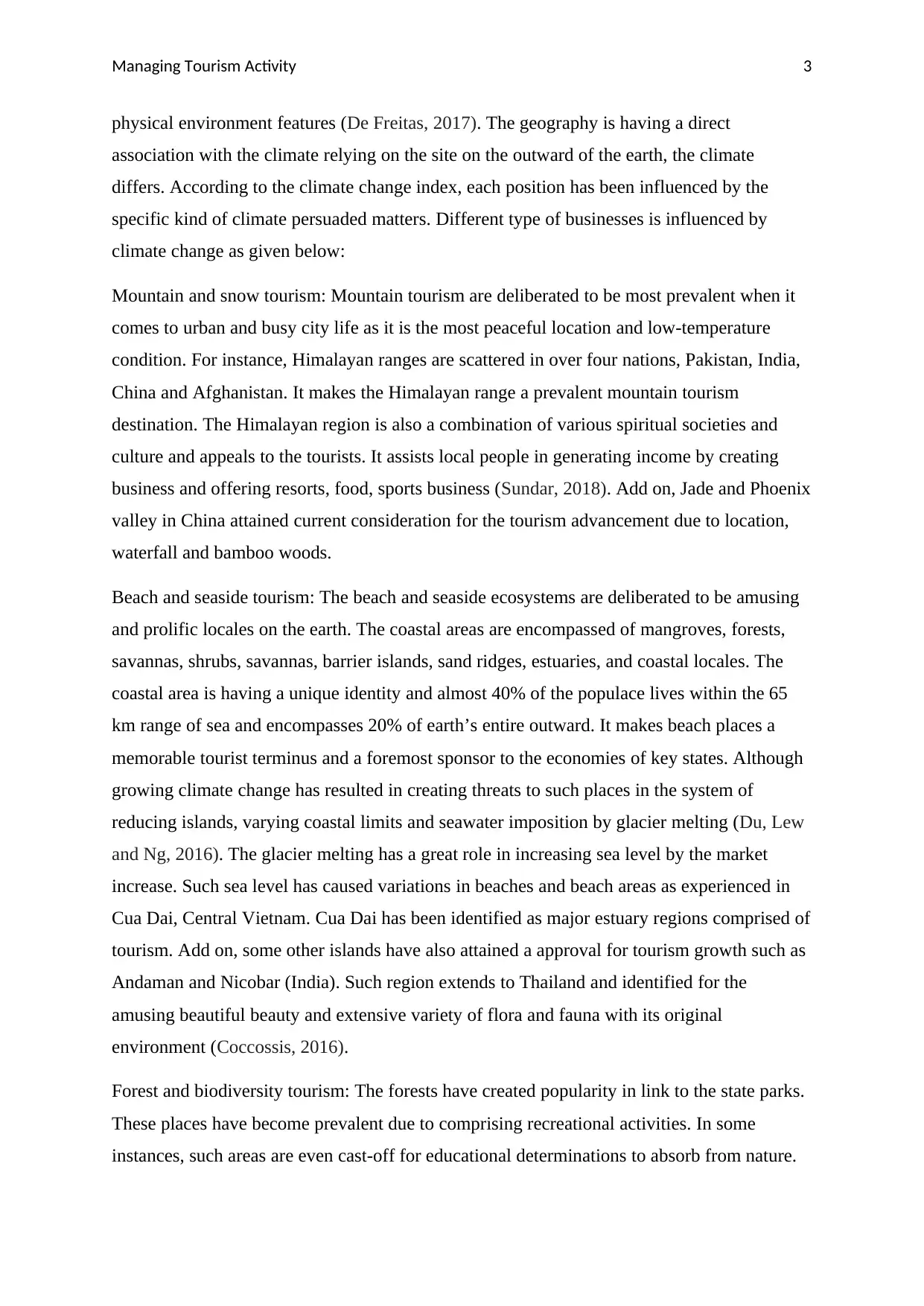
Managing Tourism Activity 3
physical environment features (De Freitas, 2017). The geography is having a direct
association with the climate relying on the site on the outward of the earth, the climate
differs. According to the climate change index, each position has been influenced by the
specific kind of climate persuaded matters. Different type of businesses is influenced by
climate change as given below:
Mountain and snow tourism: Mountain tourism are deliberated to be most prevalent when it
comes to urban and busy city life as it is the most peaceful location and low-temperature
condition. For instance, Himalayan ranges are scattered in over four nations, Pakistan, India,
China and Afghanistan. It makes the Himalayan range a prevalent mountain tourism
destination. The Himalayan region is also a combination of various spiritual societies and
culture and appeals to the tourists. It assists local people in generating income by creating
business and offering resorts, food, sports business (Sundar, 2018). Add on, Jade and Phoenix
valley in China attained current consideration for the tourism advancement due to location,
waterfall and bamboo woods.
Beach and seaside tourism: The beach and seaside ecosystems are deliberated to be amusing
and prolific locales on the earth. The coastal areas are encompassed of mangroves, forests,
savannas, shrubs, savannas, barrier islands, sand ridges, estuaries, and coastal locales. The
coastal area is having a unique identity and almost 40% of the populace lives within the 65
km range of sea and encompasses 20% of earth’s entire outward. It makes beach places a
memorable tourist terminus and a foremost sponsor to the economies of key states. Although
growing climate change has resulted in creating threats to such places in the system of
reducing islands, varying coastal limits and seawater imposition by glacier melting (Du, Lew
and Ng, 2016). The glacier melting has a great role in increasing sea level by the market
increase. Such sea level has caused variations in beaches and beach areas as experienced in
Cua Dai, Central Vietnam. Cua Dai has been identified as major estuary regions comprised of
tourism. Add on, some other islands have also attained a approval for tourism growth such as
Andaman and Nicobar (India). Such region extends to Thailand and identified for the
amusing beautiful beauty and extensive variety of flora and fauna with its original
environment (Coccossis, 2016).
Forest and biodiversity tourism: The forests have created popularity in link to the state parks.
These places have become prevalent due to comprising recreational activities. In some
instances, such areas are even cast-off for educational determinations to absorb from nature.
physical environment features (De Freitas, 2017). The geography is having a direct
association with the climate relying on the site on the outward of the earth, the climate
differs. According to the climate change index, each position has been influenced by the
specific kind of climate persuaded matters. Different type of businesses is influenced by
climate change as given below:
Mountain and snow tourism: Mountain tourism are deliberated to be most prevalent when it
comes to urban and busy city life as it is the most peaceful location and low-temperature
condition. For instance, Himalayan ranges are scattered in over four nations, Pakistan, India,
China and Afghanistan. It makes the Himalayan range a prevalent mountain tourism
destination. The Himalayan region is also a combination of various spiritual societies and
culture and appeals to the tourists. It assists local people in generating income by creating
business and offering resorts, food, sports business (Sundar, 2018). Add on, Jade and Phoenix
valley in China attained current consideration for the tourism advancement due to location,
waterfall and bamboo woods.
Beach and seaside tourism: The beach and seaside ecosystems are deliberated to be amusing
and prolific locales on the earth. The coastal areas are encompassed of mangroves, forests,
savannas, shrubs, savannas, barrier islands, sand ridges, estuaries, and coastal locales. The
coastal area is having a unique identity and almost 40% of the populace lives within the 65
km range of sea and encompasses 20% of earth’s entire outward. It makes beach places a
memorable tourist terminus and a foremost sponsor to the economies of key states. Although
growing climate change has resulted in creating threats to such places in the system of
reducing islands, varying coastal limits and seawater imposition by glacier melting (Du, Lew
and Ng, 2016). The glacier melting has a great role in increasing sea level by the market
increase. Such sea level has caused variations in beaches and beach areas as experienced in
Cua Dai, Central Vietnam. Cua Dai has been identified as major estuary regions comprised of
tourism. Add on, some other islands have also attained a approval for tourism growth such as
Andaman and Nicobar (India). Such region extends to Thailand and identified for the
amusing beautiful beauty and extensive variety of flora and fauna with its original
environment (Coccossis, 2016).
Forest and biodiversity tourism: The forests have created popularity in link to the state parks.
These places have become prevalent due to comprising recreational activities. In some
instances, such areas are even cast-off for educational determinations to absorb from nature.
Secure Best Marks with AI Grader
Need help grading? Try our AI Grader for instant feedback on your assignments.
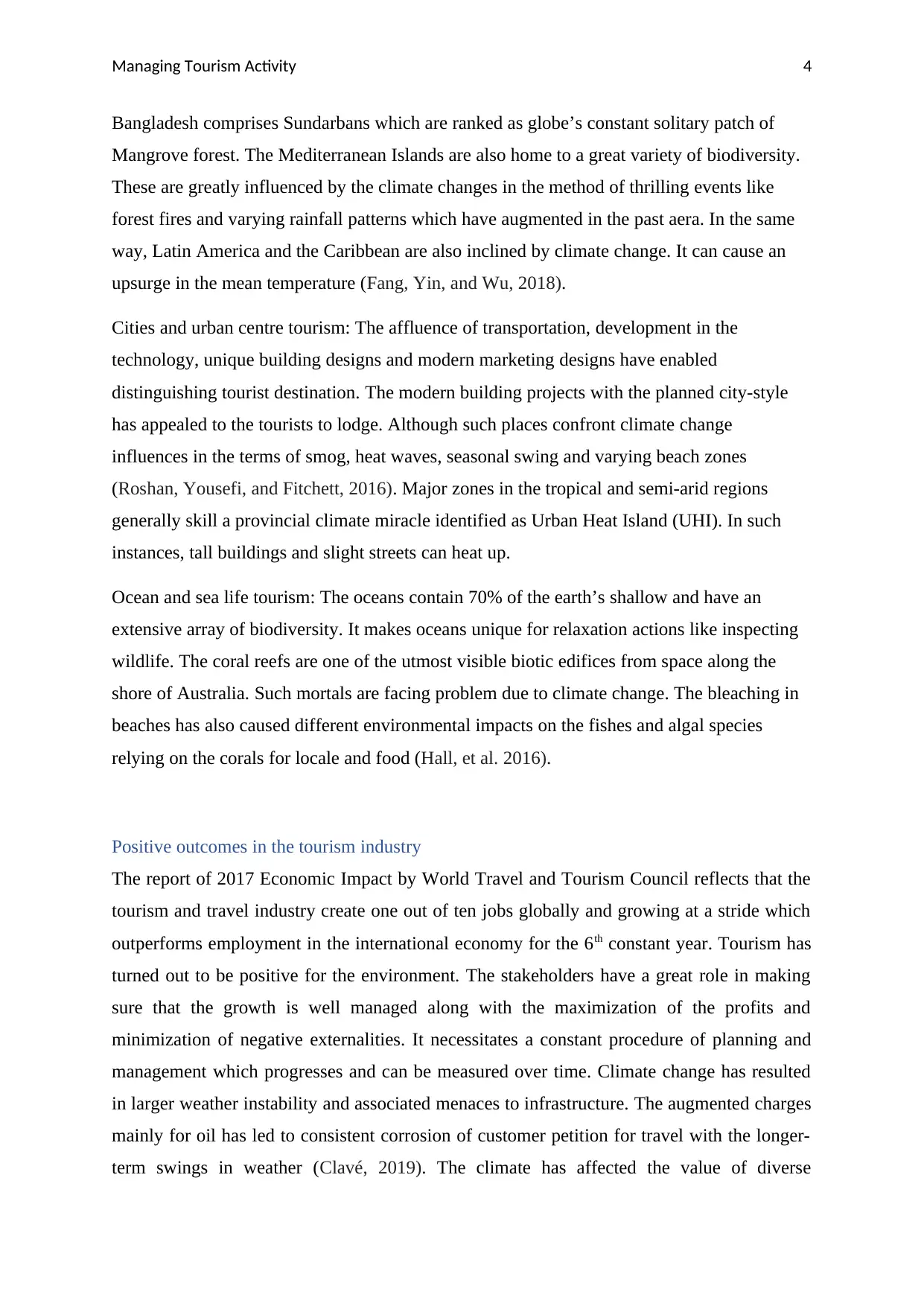
Managing Tourism Activity 4
Bangladesh comprises Sundarbans which are ranked as globe’s constant solitary patch of
Mangrove forest. The Mediterranean Islands are also home to a great variety of biodiversity.
These are greatly influenced by the climate changes in the method of thrilling events like
forest fires and varying rainfall patterns which have augmented in the past aera. In the same
way, Latin America and the Caribbean are also inclined by climate change. It can cause an
upsurge in the mean temperature (Fang, Yin, and Wu, 2018).
Cities and urban centre tourism: The affluence of transportation, development in the
technology, unique building designs and modern marketing designs have enabled
distinguishing tourist destination. The modern building projects with the planned city-style
has appealed to the tourists to lodge. Although such places confront climate change
influences in the terms of smog, heat waves, seasonal swing and varying beach zones
(Roshan, Yousefi, and Fitchett, 2016). Major zones in the tropical and semi-arid regions
generally skill a provincial climate miracle identified as Urban Heat Island (UHI). In such
instances, tall buildings and slight streets can heat up.
Ocean and sea life tourism: The oceans contain 70% of the earth’s shallow and have an
extensive array of biodiversity. It makes oceans unique for relaxation actions like inspecting
wildlife. The coral reefs are one of the utmost visible biotic edifices from space along the
shore of Australia. Such mortals are facing problem due to climate change. The bleaching in
beaches has also caused different environmental impacts on the fishes and algal species
relying on the corals for locale and food (Hall, et al. 2016).
Positive outcomes in the tourism industry
The report of 2017 Economic Impact by World Travel and Tourism Council reflects that the
tourism and travel industry create one out of ten jobs globally and growing at a stride which
outperforms employment in the international economy for the 6th constant year. Tourism has
turned out to be positive for the environment. The stakeholders have a great role in making
sure that the growth is well managed along with the maximization of the profits and
minimization of negative externalities. It necessitates a constant procedure of planning and
management which progresses and can be measured over time. Climate change has resulted
in larger weather instability and associated menaces to infrastructure. The augmented charges
mainly for oil has led to consistent corrosion of customer petition for travel with the longer-
term swings in weather (Clavé, 2019). The climate has affected the value of diverse
Bangladesh comprises Sundarbans which are ranked as globe’s constant solitary patch of
Mangrove forest. The Mediterranean Islands are also home to a great variety of biodiversity.
These are greatly influenced by the climate changes in the method of thrilling events like
forest fires and varying rainfall patterns which have augmented in the past aera. In the same
way, Latin America and the Caribbean are also inclined by climate change. It can cause an
upsurge in the mean temperature (Fang, Yin, and Wu, 2018).
Cities and urban centre tourism: The affluence of transportation, development in the
technology, unique building designs and modern marketing designs have enabled
distinguishing tourist destination. The modern building projects with the planned city-style
has appealed to the tourists to lodge. Although such places confront climate change
influences in the terms of smog, heat waves, seasonal swing and varying beach zones
(Roshan, Yousefi, and Fitchett, 2016). Major zones in the tropical and semi-arid regions
generally skill a provincial climate miracle identified as Urban Heat Island (UHI). In such
instances, tall buildings and slight streets can heat up.
Ocean and sea life tourism: The oceans contain 70% of the earth’s shallow and have an
extensive array of biodiversity. It makes oceans unique for relaxation actions like inspecting
wildlife. The coral reefs are one of the utmost visible biotic edifices from space along the
shore of Australia. Such mortals are facing problem due to climate change. The bleaching in
beaches has also caused different environmental impacts on the fishes and algal species
relying on the corals for locale and food (Hall, et al. 2016).
Positive outcomes in the tourism industry
The report of 2017 Economic Impact by World Travel and Tourism Council reflects that the
tourism and travel industry create one out of ten jobs globally and growing at a stride which
outperforms employment in the international economy for the 6th constant year. Tourism has
turned out to be positive for the environment. The stakeholders have a great role in making
sure that the growth is well managed along with the maximization of the profits and
minimization of negative externalities. It necessitates a constant procedure of planning and
management which progresses and can be measured over time. Climate change has resulted
in larger weather instability and associated menaces to infrastructure. The augmented charges
mainly for oil has led to consistent corrosion of customer petition for travel with the longer-
term swings in weather (Clavé, 2019). The climate has affected the value of diverse
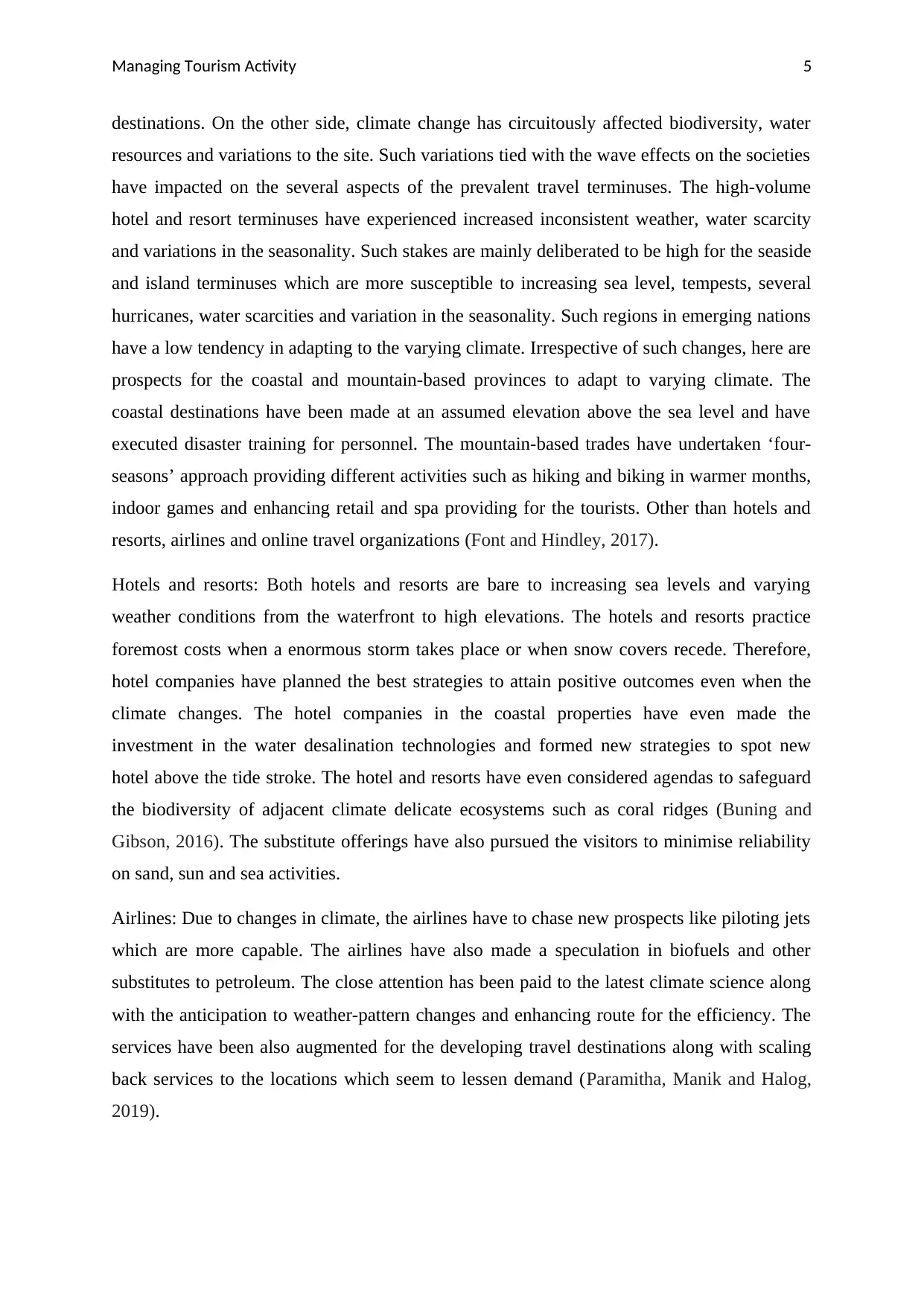
Managing Tourism Activity 5
destinations. On the other side, climate change has circuitously affected biodiversity, water
resources and variations to the site. Such variations tied with the wave effects on the societies
have impacted on the several aspects of the prevalent travel terminuses. The high-volume
hotel and resort terminuses have experienced increased inconsistent weather, water scarcity
and variations in the seasonality. Such stakes are mainly deliberated to be high for the seaside
and island terminuses which are more susceptible to increasing sea level, tempests, several
hurricanes, water scarcities and variation in the seasonality. Such regions in emerging nations
have a low tendency in adapting to the varying climate. Irrespective of such changes, here are
prospects for the coastal and mountain-based provinces to adapt to varying climate. The
coastal destinations have been made at an assumed elevation above the sea level and have
executed disaster training for personnel. The mountain-based trades have undertaken ‘four-
seasons’ approach providing different activities such as hiking and biking in warmer months,
indoor games and enhancing retail and spa providing for the tourists. Other than hotels and
resorts, airlines and online travel organizations (Font and Hindley, 2017).
Hotels and resorts: Both hotels and resorts are bare to increasing sea levels and varying
weather conditions from the waterfront to high elevations. The hotels and resorts practice
foremost costs when a enormous storm takes place or when snow covers recede. Therefore,
hotel companies have planned the best strategies to attain positive outcomes even when the
climate changes. The hotel companies in the coastal properties have even made the
investment in the water desalination technologies and formed new strategies to spot new
hotel above the tide stroke. The hotel and resorts have even considered agendas to safeguard
the biodiversity of adjacent climate delicate ecosystems such as coral ridges (Buning and
Gibson, 2016). The substitute offerings have also pursued the visitors to minimise reliability
on sand, sun and sea activities.
Airlines: Due to changes in climate, the airlines have to chase new prospects like piloting jets
which are more capable. The airlines have also made a speculation in biofuels and other
substitutes to petroleum. The close attention has been paid to the latest climate science along
with the anticipation to weather-pattern changes and enhancing route for the efficiency. The
services have been also augmented for the developing travel destinations along with scaling
back services to the locations which seem to lessen demand (Paramitha, Manik and Halog,
2019).
destinations. On the other side, climate change has circuitously affected biodiversity, water
resources and variations to the site. Such variations tied with the wave effects on the societies
have impacted on the several aspects of the prevalent travel terminuses. The high-volume
hotel and resort terminuses have experienced increased inconsistent weather, water scarcity
and variations in the seasonality. Such stakes are mainly deliberated to be high for the seaside
and island terminuses which are more susceptible to increasing sea level, tempests, several
hurricanes, water scarcities and variation in the seasonality. Such regions in emerging nations
have a low tendency in adapting to the varying climate. Irrespective of such changes, here are
prospects for the coastal and mountain-based provinces to adapt to varying climate. The
coastal destinations have been made at an assumed elevation above the sea level and have
executed disaster training for personnel. The mountain-based trades have undertaken ‘four-
seasons’ approach providing different activities such as hiking and biking in warmer months,
indoor games and enhancing retail and spa providing for the tourists. Other than hotels and
resorts, airlines and online travel organizations (Font and Hindley, 2017).
Hotels and resorts: Both hotels and resorts are bare to increasing sea levels and varying
weather conditions from the waterfront to high elevations. The hotels and resorts practice
foremost costs when a enormous storm takes place or when snow covers recede. Therefore,
hotel companies have planned the best strategies to attain positive outcomes even when the
climate changes. The hotel companies in the coastal properties have even made the
investment in the water desalination technologies and formed new strategies to spot new
hotel above the tide stroke. The hotel and resorts have even considered agendas to safeguard
the biodiversity of adjacent climate delicate ecosystems such as coral ridges (Buning and
Gibson, 2016). The substitute offerings have also pursued the visitors to minimise reliability
on sand, sun and sea activities.
Airlines: Due to changes in climate, the airlines have to chase new prospects like piloting jets
which are more capable. The airlines have also made a speculation in biofuels and other
substitutes to petroleum. The close attention has been paid to the latest climate science along
with the anticipation to weather-pattern changes and enhancing route for the efficiency. The
services have been also augmented for the developing travel destinations along with scaling
back services to the locations which seem to lessen demand (Paramitha, Manik and Halog,
2019).
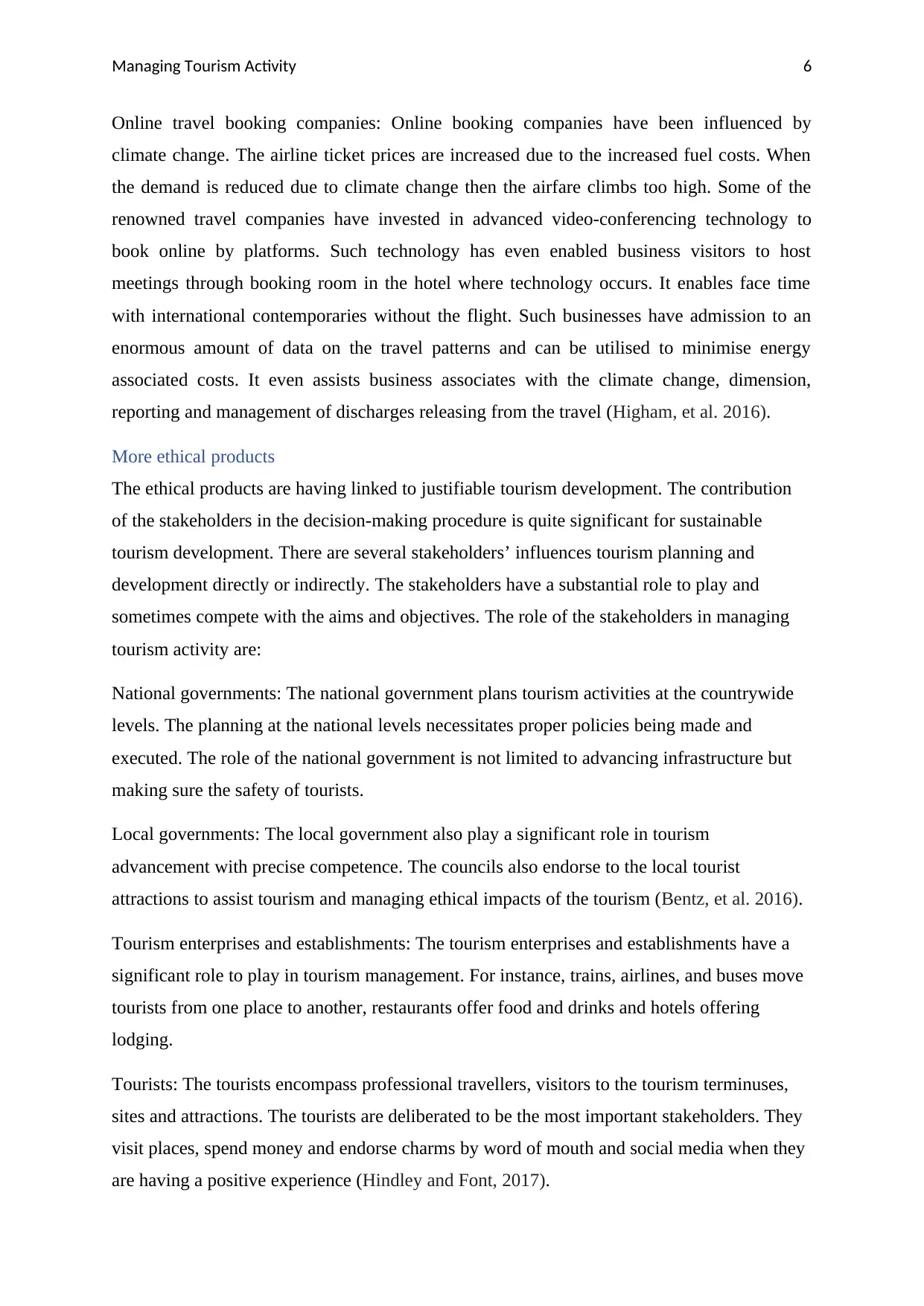
Managing Tourism Activity 6
Online travel booking companies: Online booking companies have been influenced by
climate change. The airline ticket prices are increased due to the increased fuel costs. When
the demand is reduced due to climate change then the airfare climbs too high. Some of the
renowned travel companies have invested in advanced video-conferencing technology to
book online by platforms. Such technology has even enabled business visitors to host
meetings through booking room in the hotel where technology occurs. It enables face time
with international contemporaries without the flight. Such businesses have admission to an
enormous amount of data on the travel patterns and can be utilised to minimise energy
associated costs. It even assists business associates with the climate change, dimension,
reporting and management of discharges releasing from the travel (Higham, et al. 2016).
More ethical products
The ethical products are having linked to justifiable tourism development. The contribution
of the stakeholders in the decision-making procedure is quite significant for sustainable
tourism development. There are several stakeholders’ influences tourism planning and
development directly or indirectly. The stakeholders have a substantial role to play and
sometimes compete with the aims and objectives. The role of the stakeholders in managing
tourism activity are:
National governments: The national government plans tourism activities at the countrywide
levels. The planning at the national levels necessitates proper policies being made and
executed. The role of the national government is not limited to advancing infrastructure but
making sure the safety of tourists.
Local governments: The local government also play a significant role in tourism
advancement with precise competence. The councils also endorse to the local tourist
attractions to assist tourism and managing ethical impacts of the tourism (Bentz, et al. 2016).
Tourism enterprises and establishments: The tourism enterprises and establishments have a
significant role to play in tourism management. For instance, trains, airlines, and buses move
tourists from one place to another, restaurants offer food and drinks and hotels offering
lodging.
Tourists: The tourists encompass professional travellers, visitors to the tourism terminuses,
sites and attractions. The tourists are deliberated to be the most important stakeholders. They
visit places, spend money and endorse charms by word of mouth and social media when they
are having a positive experience (Hindley and Font, 2017).
Online travel booking companies: Online booking companies have been influenced by
climate change. The airline ticket prices are increased due to the increased fuel costs. When
the demand is reduced due to climate change then the airfare climbs too high. Some of the
renowned travel companies have invested in advanced video-conferencing technology to
book online by platforms. Such technology has even enabled business visitors to host
meetings through booking room in the hotel where technology occurs. It enables face time
with international contemporaries without the flight. Such businesses have admission to an
enormous amount of data on the travel patterns and can be utilised to minimise energy
associated costs. It even assists business associates with the climate change, dimension,
reporting and management of discharges releasing from the travel (Higham, et al. 2016).
More ethical products
The ethical products are having linked to justifiable tourism development. The contribution
of the stakeholders in the decision-making procedure is quite significant for sustainable
tourism development. There are several stakeholders’ influences tourism planning and
development directly or indirectly. The stakeholders have a substantial role to play and
sometimes compete with the aims and objectives. The role of the stakeholders in managing
tourism activity are:
National governments: The national government plans tourism activities at the countrywide
levels. The planning at the national levels necessitates proper policies being made and
executed. The role of the national government is not limited to advancing infrastructure but
making sure the safety of tourists.
Local governments: The local government also play a significant role in tourism
advancement with precise competence. The councils also endorse to the local tourist
attractions to assist tourism and managing ethical impacts of the tourism (Bentz, et al. 2016).
Tourism enterprises and establishments: The tourism enterprises and establishments have a
significant role to play in tourism management. For instance, trains, airlines, and buses move
tourists from one place to another, restaurants offer food and drinks and hotels offering
lodging.
Tourists: The tourists encompass professional travellers, visitors to the tourism terminuses,
sites and attractions. The tourists are deliberated to be the most important stakeholders. They
visit places, spend money and endorse charms by word of mouth and social media when they
are having a positive experience (Hindley and Font, 2017).
Paraphrase This Document
Need a fresh take? Get an instant paraphrase of this document with our AI Paraphraser
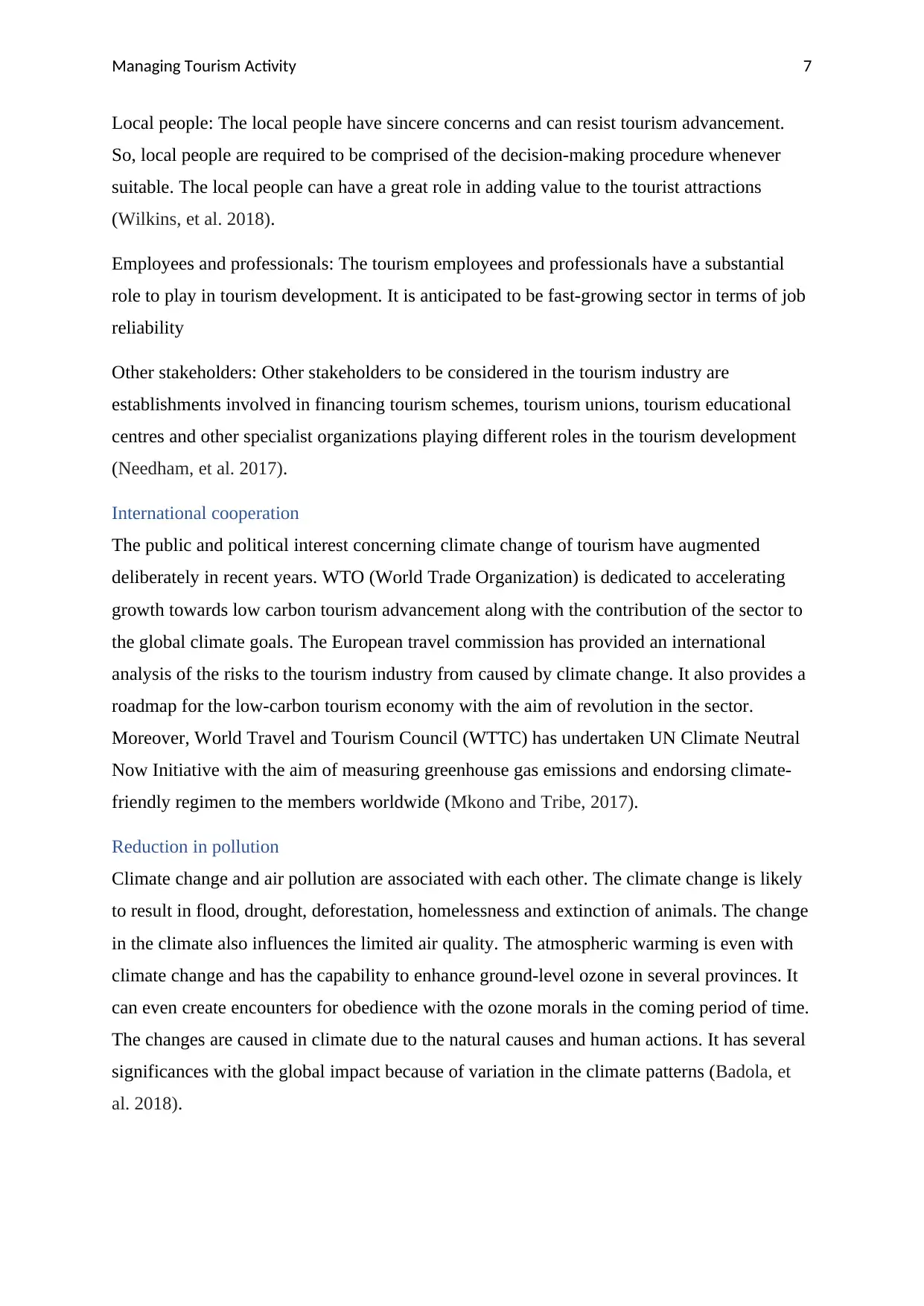
Managing Tourism Activity 7
Local people: The local people have sincere concerns and can resist tourism advancement.
So, local people are required to be comprised of the decision-making procedure whenever
suitable. The local people can have a great role in adding value to the tourist attractions
(Wilkins, et al. 2018).
Employees and professionals: The tourism employees and professionals have a substantial
role to play in tourism development. It is anticipated to be fast-growing sector in terms of job
reliability
Other stakeholders: Other stakeholders to be considered in the tourism industry are
establishments involved in financing tourism schemes, tourism unions, tourism educational
centres and other specialist organizations playing different roles in the tourism development
(Needham, et al. 2017).
International cooperation
The public and political interest concerning climate change of tourism have augmented
deliberately in recent years. WTO (World Trade Organization) is dedicated to accelerating
growth towards low carbon tourism advancement along with the contribution of the sector to
the global climate goals. The European travel commission has provided an international
analysis of the risks to the tourism industry from caused by climate change. It also provides a
roadmap for the low-carbon tourism economy with the aim of revolution in the sector.
Moreover, World Travel and Tourism Council (WTTC) has undertaken UN Climate Neutral
Now Initiative with the aim of measuring greenhouse gas emissions and endorsing climate-
friendly regimen to the members worldwide (Mkono and Tribe, 2017).
Reduction in pollution
Climate change and air pollution are associated with each other. The climate change is likely
to result in flood, drought, deforestation, homelessness and extinction of animals. The change
in the climate also influences the limited air quality. The atmospheric warming is even with
climate change and has the capability to enhance ground-level ozone in several provinces. It
can even create encounters for obedience with the ozone morals in the coming period of time.
The changes are caused in climate due to the natural causes and human actions. It has several
significances with the global impact because of variation in the climate patterns (Badola, et
al. 2018).
Local people: The local people have sincere concerns and can resist tourism advancement.
So, local people are required to be comprised of the decision-making procedure whenever
suitable. The local people can have a great role in adding value to the tourist attractions
(Wilkins, et al. 2018).
Employees and professionals: The tourism employees and professionals have a substantial
role to play in tourism development. It is anticipated to be fast-growing sector in terms of job
reliability
Other stakeholders: Other stakeholders to be considered in the tourism industry are
establishments involved in financing tourism schemes, tourism unions, tourism educational
centres and other specialist organizations playing different roles in the tourism development
(Needham, et al. 2017).
International cooperation
The public and political interest concerning climate change of tourism have augmented
deliberately in recent years. WTO (World Trade Organization) is dedicated to accelerating
growth towards low carbon tourism advancement along with the contribution of the sector to
the global climate goals. The European travel commission has provided an international
analysis of the risks to the tourism industry from caused by climate change. It also provides a
roadmap for the low-carbon tourism economy with the aim of revolution in the sector.
Moreover, World Travel and Tourism Council (WTTC) has undertaken UN Climate Neutral
Now Initiative with the aim of measuring greenhouse gas emissions and endorsing climate-
friendly regimen to the members worldwide (Mkono and Tribe, 2017).
Reduction in pollution
Climate change and air pollution are associated with each other. The climate change is likely
to result in flood, drought, deforestation, homelessness and extinction of animals. The change
in the climate also influences the limited air quality. The atmospheric warming is even with
climate change and has the capability to enhance ground-level ozone in several provinces. It
can even create encounters for obedience with the ozone morals in the coming period of time.
The changes are caused in climate due to the natural causes and human actions. It has several
significances with the global impact because of variation in the climate patterns (Badola, et
al. 2018).
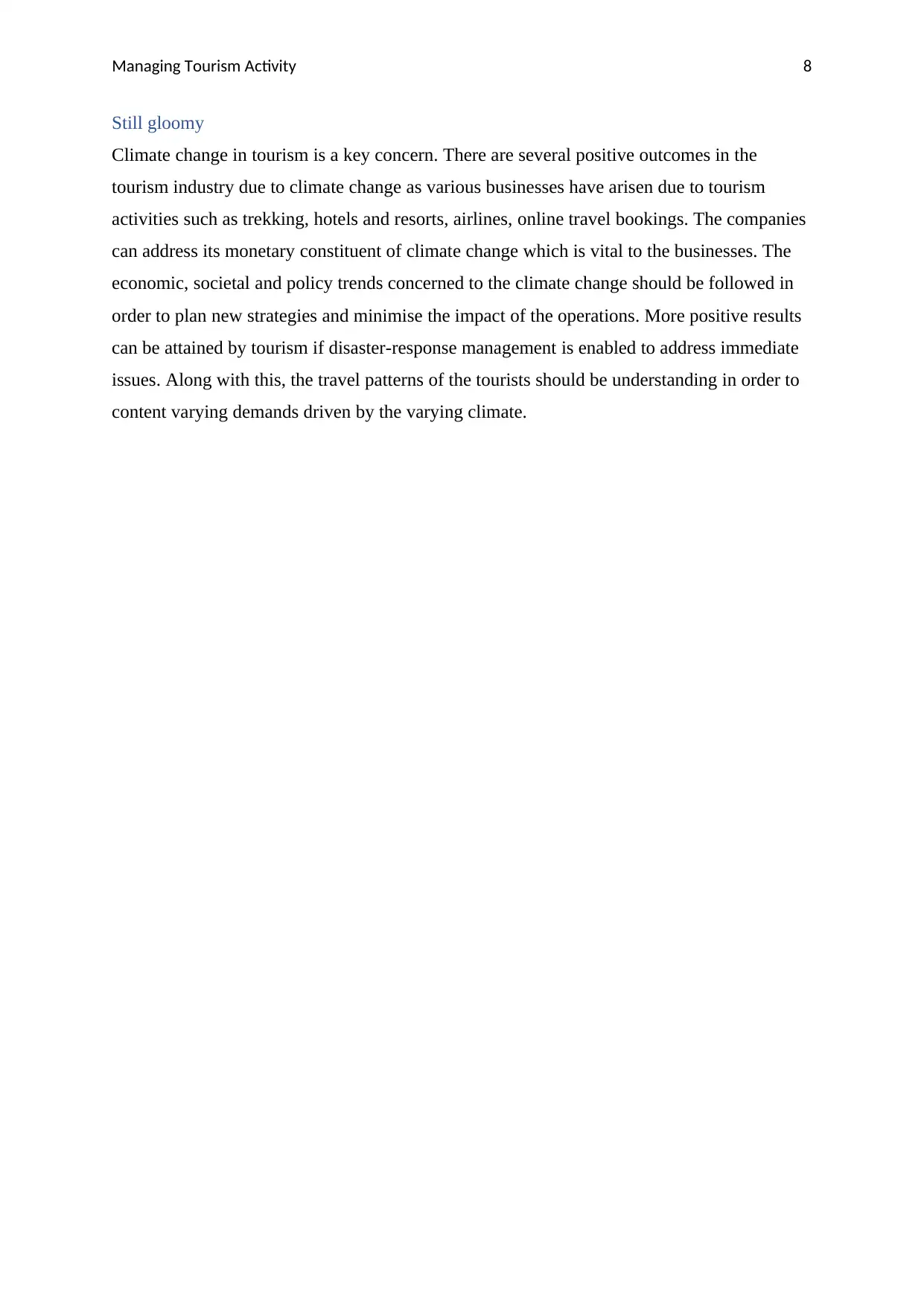
Managing Tourism Activity 8
Still gloomy
Climate change in tourism is a key concern. There are several positive outcomes in the
tourism industry due to climate change as various businesses have arisen due to tourism
activities such as trekking, hotels and resorts, airlines, online travel bookings. The companies
can address its monetary constituent of climate change which is vital to the businesses. The
economic, societal and policy trends concerned to the climate change should be followed in
order to plan new strategies and minimise the impact of the operations. More positive results
can be attained by tourism if disaster-response management is enabled to address immediate
issues. Along with this, the travel patterns of the tourists should be understanding in order to
content varying demands driven by the varying climate.
Still gloomy
Climate change in tourism is a key concern. There are several positive outcomes in the
tourism industry due to climate change as various businesses have arisen due to tourism
activities such as trekking, hotels and resorts, airlines, online travel bookings. The companies
can address its monetary constituent of climate change which is vital to the businesses. The
economic, societal and policy trends concerned to the climate change should be followed in
order to plan new strategies and minimise the impact of the operations. More positive results
can be attained by tourism if disaster-response management is enabled to address immediate
issues. Along with this, the travel patterns of the tourists should be understanding in order to
content varying demands driven by the varying climate.
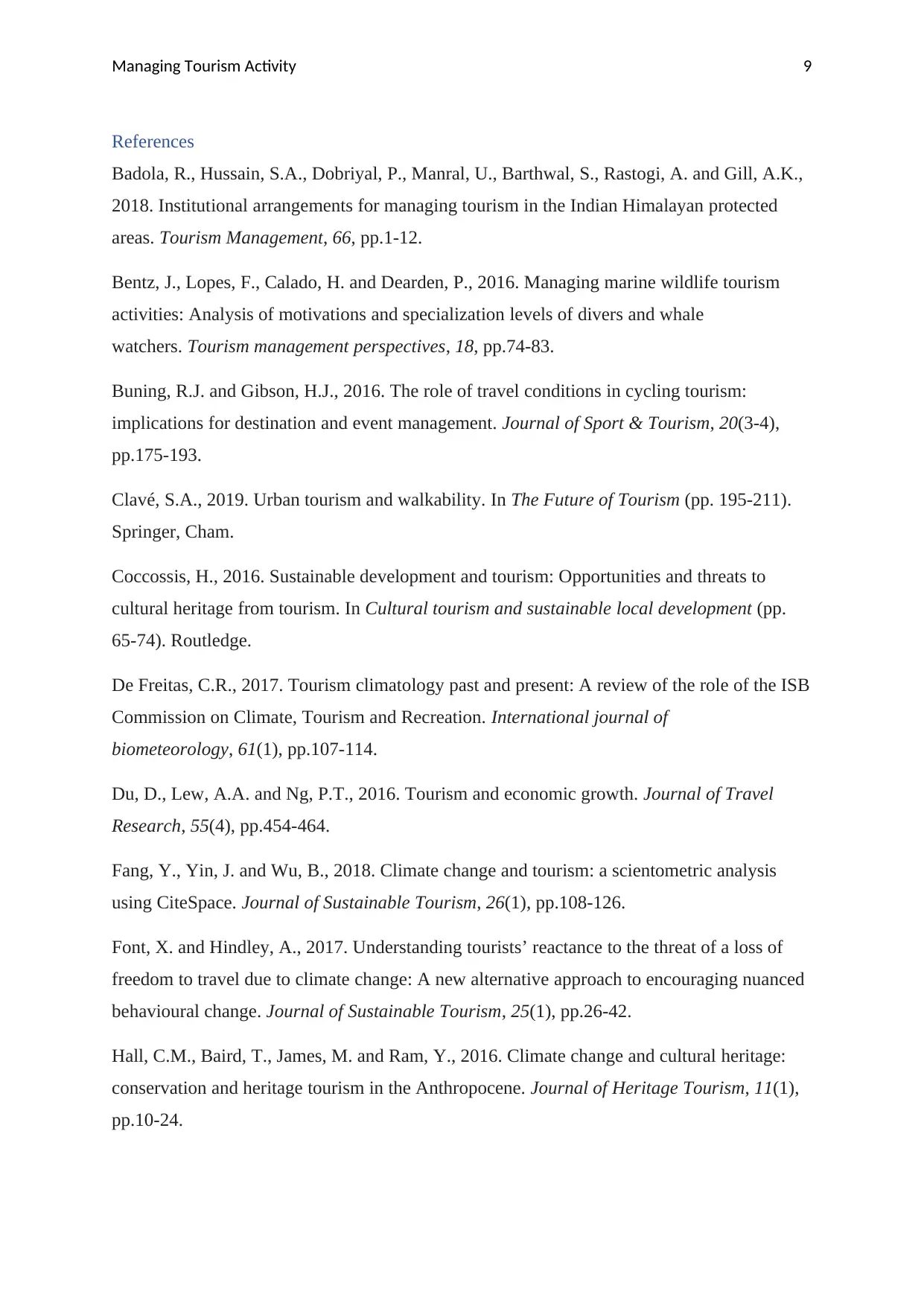
Managing Tourism Activity 9
References
Badola, R., Hussain, S.A., Dobriyal, P., Manral, U., Barthwal, S., Rastogi, A. and Gill, A.K.,
2018. Institutional arrangements for managing tourism in the Indian Himalayan protected
areas. Tourism Management, 66, pp.1-12.
Bentz, J., Lopes, F., Calado, H. and Dearden, P., 2016. Managing marine wildlife tourism
activities: Analysis of motivations and specialization levels of divers and whale
watchers. Tourism management perspectives, 18, pp.74-83.
Buning, R.J. and Gibson, H.J., 2016. The role of travel conditions in cycling tourism:
implications for destination and event management. Journal of Sport & Tourism, 20(3-4),
pp.175-193.
Clavé, S.A., 2019. Urban tourism and walkability. In The Future of Tourism (pp. 195-211).
Springer, Cham.
Coccossis, H., 2016. Sustainable development and tourism: Opportunities and threats to
cultural heritage from tourism. In Cultural tourism and sustainable local development (pp.
65-74). Routledge.
De Freitas, C.R., 2017. Tourism climatology past and present: A review of the role of the ISB
Commission on Climate, Tourism and Recreation. International journal of
biometeorology, 61(1), pp.107-114.
Du, D., Lew, A.A. and Ng, P.T., 2016. Tourism and economic growth. Journal of Travel
Research, 55(4), pp.454-464.
Fang, Y., Yin, J. and Wu, B., 2018. Climate change and tourism: a scientometric analysis
using CiteSpace. Journal of Sustainable Tourism, 26(1), pp.108-126.
Font, X. and Hindley, A., 2017. Understanding tourists’ reactance to the threat of a loss of
freedom to travel due to climate change: A new alternative approach to encouraging nuanced
behavioural change. Journal of Sustainable Tourism, 25(1), pp.26-42.
Hall, C.M., Baird, T., James, M. and Ram, Y., 2016. Climate change and cultural heritage:
conservation and heritage tourism in the Anthropocene. Journal of Heritage Tourism, 11(1),
pp.10-24.
References
Badola, R., Hussain, S.A., Dobriyal, P., Manral, U., Barthwal, S., Rastogi, A. and Gill, A.K.,
2018. Institutional arrangements for managing tourism in the Indian Himalayan protected
areas. Tourism Management, 66, pp.1-12.
Bentz, J., Lopes, F., Calado, H. and Dearden, P., 2016. Managing marine wildlife tourism
activities: Analysis of motivations and specialization levels of divers and whale
watchers. Tourism management perspectives, 18, pp.74-83.
Buning, R.J. and Gibson, H.J., 2016. The role of travel conditions in cycling tourism:
implications for destination and event management. Journal of Sport & Tourism, 20(3-4),
pp.175-193.
Clavé, S.A., 2019. Urban tourism and walkability. In The Future of Tourism (pp. 195-211).
Springer, Cham.
Coccossis, H., 2016. Sustainable development and tourism: Opportunities and threats to
cultural heritage from tourism. In Cultural tourism and sustainable local development (pp.
65-74). Routledge.
De Freitas, C.R., 2017. Tourism climatology past and present: A review of the role of the ISB
Commission on Climate, Tourism and Recreation. International journal of
biometeorology, 61(1), pp.107-114.
Du, D., Lew, A.A. and Ng, P.T., 2016. Tourism and economic growth. Journal of Travel
Research, 55(4), pp.454-464.
Fang, Y., Yin, J. and Wu, B., 2018. Climate change and tourism: a scientometric analysis
using CiteSpace. Journal of Sustainable Tourism, 26(1), pp.108-126.
Font, X. and Hindley, A., 2017. Understanding tourists’ reactance to the threat of a loss of
freedom to travel due to climate change: A new alternative approach to encouraging nuanced
behavioural change. Journal of Sustainable Tourism, 25(1), pp.26-42.
Hall, C.M., Baird, T., James, M. and Ram, Y., 2016. Climate change and cultural heritage:
conservation and heritage tourism in the Anthropocene. Journal of Heritage Tourism, 11(1),
pp.10-24.
Secure Best Marks with AI Grader
Need help grading? Try our AI Grader for instant feedback on your assignments.
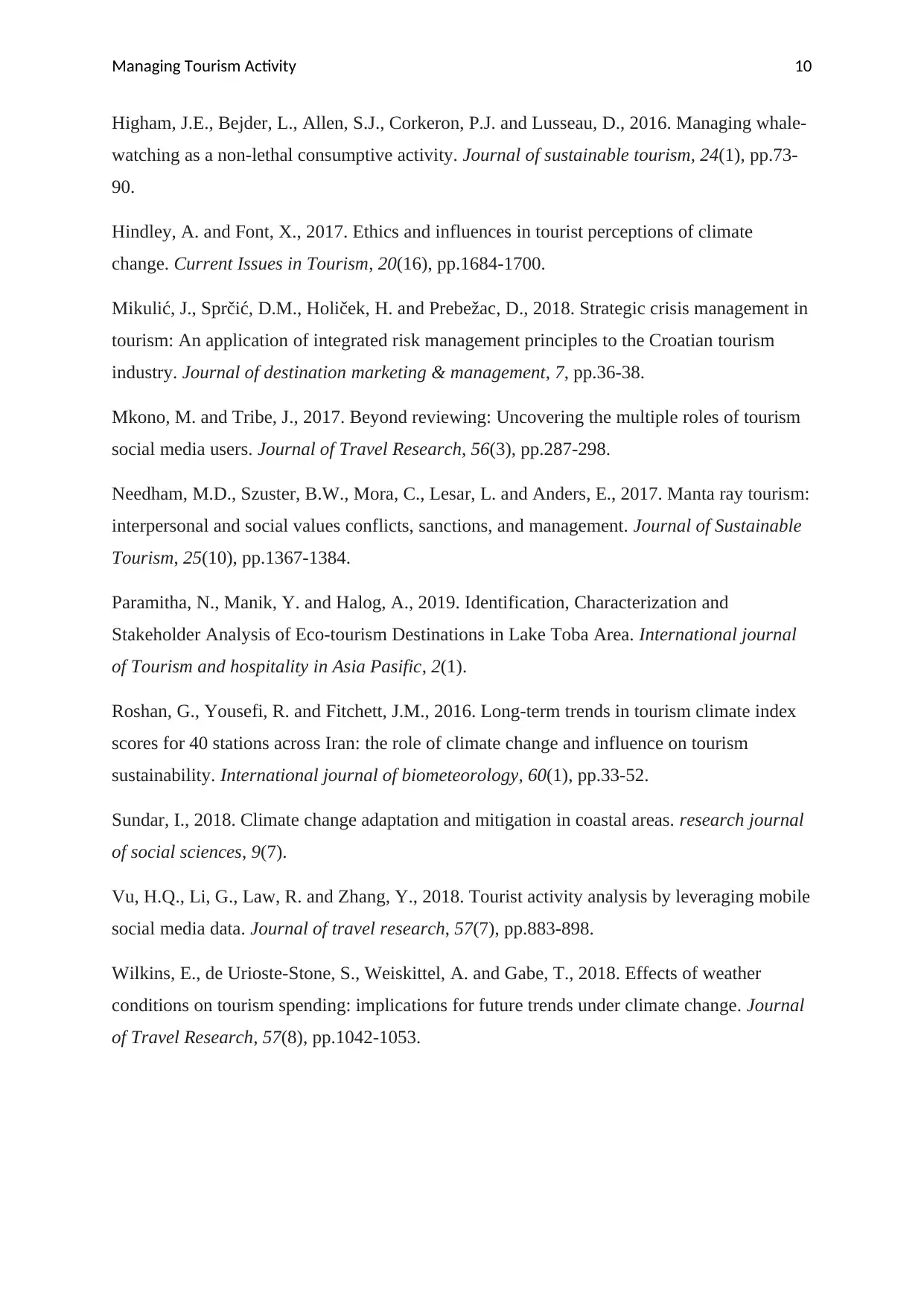
Managing Tourism Activity 10
Higham, J.E., Bejder, L., Allen, S.J., Corkeron, P.J. and Lusseau, D., 2016. Managing whale-
watching as a non-lethal consumptive activity. Journal of sustainable tourism, 24(1), pp.73-
90.
Hindley, A. and Font, X., 2017. Ethics and influences in tourist perceptions of climate
change. Current Issues in Tourism, 20(16), pp.1684-1700.
Mikulić, J., Sprčić, D.M., Holiček, H. and Prebežac, D., 2018. Strategic crisis management in
tourism: An application of integrated risk management principles to the Croatian tourism
industry. Journal of destination marketing & management, 7, pp.36-38.
Mkono, M. and Tribe, J., 2017. Beyond reviewing: Uncovering the multiple roles of tourism
social media users. Journal of Travel Research, 56(3), pp.287-298.
Needham, M.D., Szuster, B.W., Mora, C., Lesar, L. and Anders, E., 2017. Manta ray tourism:
interpersonal and social values conflicts, sanctions, and management. Journal of Sustainable
Tourism, 25(10), pp.1367-1384.
Paramitha, N., Manik, Y. and Halog, A., 2019. Identification, Characterization and
Stakeholder Analysis of Eco-tourism Destinations in Lake Toba Area. International journal
of Tourism and hospitality in Asia Pasific, 2(1).
Roshan, G., Yousefi, R. and Fitchett, J.M., 2016. Long-term trends in tourism climate index
scores for 40 stations across Iran: the role of climate change and influence on tourism
sustainability. International journal of biometeorology, 60(1), pp.33-52.
Sundar, I., 2018. Climate change adaptation and mitigation in coastal areas. research journal
of social sciences, 9(7).
Vu, H.Q., Li, G., Law, R. and Zhang, Y., 2018. Tourist activity analysis by leveraging mobile
social media data. Journal of travel research, 57(7), pp.883-898.
Wilkins, E., de Urioste-Stone, S., Weiskittel, A. and Gabe, T., 2018. Effects of weather
conditions on tourism spending: implications for future trends under climate change. Journal
of Travel Research, 57(8), pp.1042-1053.
Higham, J.E., Bejder, L., Allen, S.J., Corkeron, P.J. and Lusseau, D., 2016. Managing whale-
watching as a non-lethal consumptive activity. Journal of sustainable tourism, 24(1), pp.73-
90.
Hindley, A. and Font, X., 2017. Ethics and influences in tourist perceptions of climate
change. Current Issues in Tourism, 20(16), pp.1684-1700.
Mikulić, J., Sprčić, D.M., Holiček, H. and Prebežac, D., 2018. Strategic crisis management in
tourism: An application of integrated risk management principles to the Croatian tourism
industry. Journal of destination marketing & management, 7, pp.36-38.
Mkono, M. and Tribe, J., 2017. Beyond reviewing: Uncovering the multiple roles of tourism
social media users. Journal of Travel Research, 56(3), pp.287-298.
Needham, M.D., Szuster, B.W., Mora, C., Lesar, L. and Anders, E., 2017. Manta ray tourism:
interpersonal and social values conflicts, sanctions, and management. Journal of Sustainable
Tourism, 25(10), pp.1367-1384.
Paramitha, N., Manik, Y. and Halog, A., 2019. Identification, Characterization and
Stakeholder Analysis of Eco-tourism Destinations in Lake Toba Area. International journal
of Tourism and hospitality in Asia Pasific, 2(1).
Roshan, G., Yousefi, R. and Fitchett, J.M., 2016. Long-term trends in tourism climate index
scores for 40 stations across Iran: the role of climate change and influence on tourism
sustainability. International journal of biometeorology, 60(1), pp.33-52.
Sundar, I., 2018. Climate change adaptation and mitigation in coastal areas. research journal
of social sciences, 9(7).
Vu, H.Q., Li, G., Law, R. and Zhang, Y., 2018. Tourist activity analysis by leveraging mobile
social media data. Journal of travel research, 57(7), pp.883-898.
Wilkins, E., de Urioste-Stone, S., Weiskittel, A. and Gabe, T., 2018. Effects of weather
conditions on tourism spending: implications for future trends under climate change. Journal
of Travel Research, 57(8), pp.1042-1053.

Managing Tourism Activity 11
1 out of 12
Related Documents
Your All-in-One AI-Powered Toolkit for Academic Success.
+13062052269
info@desklib.com
Available 24*7 on WhatsApp / Email
![[object Object]](/_next/static/media/star-bottom.7253800d.svg)
Unlock your academic potential
© 2024 | Zucol Services PVT LTD | All rights reserved.





